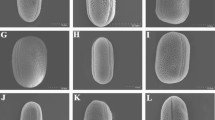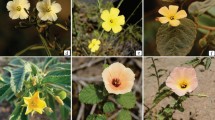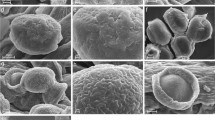Abstract
The pollen morphology of the tribe Sorbarieae (Adenostoma, Chamaebatiaria, Sorbaria, and Spiraeanthus) and two related genera Gillenia and Lyonothamnus was investigated by light, scanning electron, and transmission electron microscopy. Sorbarieae pollen was monad, tri-colporate, small to medium in size (P = 10.2–40.0 μm, E = 10.8–32.4 μm), and oblate to prolate in shape (P/E = 0.74–1.88). The sexine ornamentation was striate, but four different types could be divided: striate-psilate, striate-plicate, striate-microechinate, and striate-perforate. The pollen wall stratification typically consisted of unbranched columellae and a continuous endexine. As an additional palynological characteristic, orbicules (small sporopollenin granules) were observed in all taxa and thus a possible synapomorphic character of Sorbarieae as a whole. The pollen characteristics are useful to recognize certain taxa. Gillenia is the only genus with both a pore flap on the aperture and the perforated sexine. Lyonothamnus has a significantly thick exine and relatively larger pollen grains, which is compared to that of Sorbarieae. Some quantitative characteristics (e.g., pollen and colpus size, exine thickness, and ridge width of striae) identified using principal components analysis (PCA) may have diagnostic importance among the taxa in the tribe.






Similar content being viewed by others
References
Bigazzi M, Tardelli M (1990) Pollen morphology and ultrastructure of the Old World Antirrhineae (Scrophulariaceae). Grana 29:257–275. doi:10.1080/00173139009428937
Chang NK (1986) Sorbaria. In: Ministry of Education (ed) Illustrated Flora and Fauna of Korea, vol 29. Pollen, Seoul, pp 561–562
Chung KS, Elisens WJ, Skvarla JJ (2010) Pollen morphology and its phylogenetic significance in tribe Sanguisorbeae (Rosaceae). Pl Syst Evol 285:139–148. doi:10.1007/s00606-009-0262-9
Demissew S, Harley MM (1992) Trichome, seed surface and pollen characters in Stachys (Labiatae) in Tropical Africa. In: Harley RM, Reynolds T (eds) Advances in labiatae science. Royal Botanic Gardens, Kew, pp 149–166
Dönmez AA (2008) Pollen morphology in Turkish Crataegus (Rosaceae). Bot Helv 118:59–70. doi:10.1007/s00035-008-0823-5
Eide F (1981) Key for northwest European Rosaceae pollen. Grana 20:101–118. doi:10.1080/00173138109427651
Erdtman G (1960) The acetolysis method: a revised description. Svensk Bot Tidskr 54:561–564
Faegri K, Iversen J (1950) Textbook of modern pollen analysis. Munksgaard, Copenhagen
Geeraerts A, Raeymaekers JAM, Vinckier S, Pletsers A, Smets E, Huysmans S (2009) Systematic palynology in Ebenaceae with focus on Ebenoideae: morphological diversity and character evolution. Rev Palaeobot Palynol 153:336–353. doi:10.1016/j.revpalbo.2008.10.001
Hebda RJ, Chinnappa CC (1990a) Pollen morphology of the Rosaceae of Western Canada. III. Geum. Canad J Bot 68:1369–1378. doi:10.1139/b90-175
Hebda RJ, Chinnappa CC (1990b) Studies on pollen morphology of Rosaceae in Canada. Rev Palaeobot Palynol 64:103–108. doi:10.1016/0034-6667(90)90123-Z
Hebda RJ, Chinnappa CC (1994) Studies on pollen morphology of Rosaceae. Acta Bot Gallica 141:183–193. doi:10.1080/12538078.1994.10515150
Hebda RJ, Chinnappa CC, Smith BM (1988a) Pollen morphology of the Rosaceae of Western Canada. I. Agrimonia to Crataegus. Grana 27:95–113. doi:10.1080/00173138809432836
Hebda RJ, Chinnappa CC, Smith BM (1988b) Pollen morphology of the Rosaceae of Western Canada. II. Dryas, Fragaria, Holodiscus. Canad J Bot 66:595–612. doi:10.1139/b88-086
Hebda RJ, Chinnappa CC, Smith BM (1991) Pollen morphology of the Rosaceae of Western Canada. IV. Luetkea, Oemleria, Physocarpus, Prunus. Canad J Bot 69:2583–2596. doi:10.1139/b91-322
Hutchinson J (1964) The genera of flowering plants, vol 1., Dicotyledons. Clarendon Press, Oxford
Huysmans S, El-Ghazaly G, Nilsson S, Smets E (1997) Systematic value of tapetal orbicules: a preliminary survey of the Cinchonoideae (Rubiaceae). Canad J Bot 75:815–826. doi:10.1139/b97-091
Huysmans S, El-Ghazaly G, Smets E (1998) Orbicules in angiosperms: morphology, function, distribution, and relation with tapetum types. Bot Rev 64:240–272. doi:10.1007/BF02856566
Huysmans S, El-Ghazaly G, Smets E (2000) Orbicules: still a well hidden secret of the anther. In: Nordenstam B, El-Ghazaly G, Kassas M (eds) Plant systematics for the 21st century, Wenner-Gren international series, vol 77. Portland Press, London, pp 201–212
Huysmans S, Verstraete B, Smets E, Chatrou LW (2010) Distribution of orbicules in Annonaceae mirrors evolutionary trend in angiosperms. Pl Ecol Evol 143:199–211. doi:10.5091/plecevo.2010.438
Jepson WL (1993) The Jepson manual: higher plants of California. University of California, Berkeley
Kalkman C (2004) Rosaceae. In: Kubitzki K (ed) The families and genera of vascular plants, vol 6., Flowering plants—Dicotyledons: Celastrales, Oxalidales, Rosales, Cornales, Ericales. Springer-Verlag, Berlin, pp 343–386
Keijzer CJ (1987) The processes of anther dehiscence and pollen dispersal. II. The formation and the transfer mechanism of pollenkitt, cell-wall development of the loculus tissues and a function of orbicules in pollen dispersal. New Phytol 105:499–507. doi:10.1111/j.1469-8137.1987.tb00887.x
Komarov VL (1916) Sorbaria rhoifolia. Bulletin du Jardin imperial botanique de Pierre le Grand 16:174
Lee ST, Jung YJ, Lee JH (1993) Palynological relationship between Pentactina rupicola Nakai and its relative taxa. Korean J Pl Taxon 23:149–159
Lee ST, Heo KI, Cho JH, Lee CH, Chen W, Kim SC (2011) New insights into pollen morphology and its implications in the phylogeny of Sanguisorba L. (Rosaceae; Sanguisorbeae). Pl Syst Evol 291:227–242. doi:10.1007/s00606-010-0384-0
McCune B, Mefford MJ (2011) PC-ORD. Multivariate analysis of ecological data. Version 6. MjM. Software, Gleneden Beach, Oregon
Moon HK, Vinckier S, Smets E, Huysmans S (2008a) Comparative pollen morphology and ultrastructure of Mentheae subtribe Nepetinae (Lamiaceae). Rev Palaeobot Palynol 149:174–198. doi:10.1016/j.revpalbo.2007.12.001
Moon HK, Vinckier S, Smets E, Huysmans S (2008b) Palynological evolutionary trends within the tribe Mentheae with special emphasis on subtribe Menthinae (Nepetoideae: lamiaceae). Pl Syst Evol 275:93–108. doi:10.1007/s00606-008-0042-y
Moon HK, Vinckier S, Walker JB, Smets E, Huysmans S (2008c) A search for phylogenetically informative pollen characters in the subtribe Salviinae (Mentheae: Lamiaceae). Int J Pl Sci 169:455–471. doi:10.1086/526463
Morgan DR, Soltis DE, Robertson KR (1994) Systematic and evolutionary implications of rbcL sequence variation in Rosaceae. Amer J Bot 81:890–903. doi:10.2307/2445770
Naruhashi N, Toyoshima Y (1979) Pollen morphology of Japanese Rosaceae. J Phytogeogr Taxon 27:46–50
Potter D, Eriksson T, Evans RC, Oh S, Smedmark JEE, Morgan DR, Kerr M, Robertson KR, Arsenault MP, Dickinson TA, Campbell CS (2007) Phylogeny and classification of Rosaceae. Pl Syst Evol 266:5–43. doi:10.1007/s00606-007-0539-9
Punt W, Hoen PP, Blackmore S, Nilsson S, Le Thomas A (2007) Glossary of pollen and spore terminology. Rev Palaeobot Palynol 143:1–81. doi:10.1016/j.revpalbo.2006.06.008
Rahn K (1989) A survey of the genus Sorbaria (Rosaceae). Nordic J Bot 8:557–563. doi:10.1111/j.1756-1051.1989.tb01728.x
Rasoamanana EN, Razanamaro O, Ramavovololona P, Ramamonjisoa RZ, Verdeil JL, Danthu P, Suárez-Cervera M (2015) Pollen wall ultrastructure of the genus Adansonia L. species. Pl Syst Evol 301:541–554. doi:10.1007/s00606-014-1091-z
Reitsma T (1969) Size modification of recent pollen grains under different treatments. Rev Palaeobot Palynol 9:175–202. doi:10.1016/0034-6667(69)90003-7
Rydberg PA (1908) Rosaceae. In: Britton NL, Coville FV, Gleason HA, Small JK, Pollard CL, Rydberg PA (eds) North American Flora, vol 22., Part 3. The New York Botanical Garden, New York, pp 239–292
Schols P, Es K, D’hondt C, Merchx V, Smets E, Huysmans S (2004) A new enzyme-based method for the treatment of fragile pollen grains collected from herbarium material. Taxon 53:777–782. doi:10.2307/4135450
Schulze-Menz GK (1964) Rosaceae. In: Melchior H (ed) Engler’s Syllabus der Pflanzenfamilien II, 12th edn. Gebrüder Borntraeger, Berlin, pp 209–218
Shi W, Wen J, Lutz S (2013) Pollen morphology of the Maddenia clade of Prunus and its taxonomic and phylogenetic implications. J Syst Evol 51:164–183. doi:10.1111/j.1759-6831.2012.00233.x
Simpson MG (1983) Pollen ultrastructure of the Haemodoraceae and its taxonomic significance. Grana 22:79–103. doi:10.1080/00173138309431969
Sokal RR, Rohlf FJ (1995) Biometry: the principles and practice of statistics in biological research. Freeman and Company, New York
Takhtajan A (1997) Diversity and classification of flowering plants. Columbia University Press, New York
Tellería MC (2008) Taxonomic significance of pollen types in the Guyana Highland-centred composite genera of Mutisioideae (Asteraceae). Bot J Linn Soc 156:327–340. doi:10.1111/j.1095-8339.2007.00745.x
Thiers B (2014) [continuously updated] Index Herbariorum: a global directory of public herbaria and associated staff. New York: Botanical Garden’s Virtual Herbarium. http://sweetgum.nybg.org/ih/. Accessed 10 Oct 2014
Tomaszewski D (2001) Sorbaria species cultivated in Poland. Dendrobiology 46:59–64
Ueda Y (1992) Pollen surface morphology in the genus Rosa related genera. Jap J Palynol 38:94–105
Ueda Y, Tomita H (1989) Morphometric analysis of pollen patterns in roses. J Jap Soc Hort Sci 581:211–220
Verstraete B, Groeninckx I, Smets E, Huysmans S (2011) Phylogenetic signal of orbicules at family level: Rubiaceae as case study. Taxon 60:742–757
Verstraete B, Moon HK, Smets E, Huysmans S (2014) Orbicules in flowering plants: a phylogenetic perspective on their form and function. Bot Rev 80:107–134. doi:10.1007/s12229-014-9135-1
Vinckier S, Smets E (2002) Systematic importance of orbicule diversity in Gentianales. Grana 41:158–182. doi:10.1080/001731302321042623
Walker JW (1976) Evolutionary significance of the exine in the pollen of primitive angiosperms. In: Ferguson IK, Muller J (eds) The Evolutionary significance of the exine. Academic Press, London, pp 251–308
Walker JW, Doyle JA (1975) The basis of angiosperm phylogeny: palynology. Ann Missouri Bot Gard 62:664–723. doi:10.2307/2395271
Wang FH, Chie NF, Zhang YL, Yang HQ (1997) Pollen flora of China, 2nd edn. Science Press, Beijing
Wrońska-Pilarek D (2011) Pollen morphology of Polish native species of the Rosa genus (Rosaceae) and its relation to systematics. Acta Soc Bot Poloniae 80:221–232. doi:10.5586/asbp.2011.031
Wrońska-Pilarek D, Jagodziński AM (2011) Systematic importance of pollen morphological features of selected species from the genus Rosa (Rosaceae). Pl Syst Evol 295:55–72. doi:10.1007/s00606-011-0462-y
Wrońska-Pilarek D, Bocianowski J, Jagodziński AM (2013) Comparison of pollen grain morphological features of selected species of the genus Crataegus (Rosaceae) and their spontaneous hybrids. Bot J Linn Soc 172:555–571. doi:10.1111/boj.12033
Xu F, Ronse Decraene LP (2013) Pollen morphology and ultrastructure of selected species from Annonaceae. Pl Syst Evol 299:11–24. doi:10.1007/s00606-012-0698-1
Zhou L, Wei ZX, Wu ZY (1999) Pollen morphology of Spiraeoideae in China (Rosaceae). Acta Bot Yunnan 21:303–308
Acknowledgments
We are grateful to our colleagues M.-J. Kong and M.-K. Ok for helping us in various ways. We also thank three anonymous reviewers and the handling editor Dr. Michael Hesse for their constructive comments. This research was supported by the Basic Science Research Program through the National Research Foundation of Korea (NRF) funded by the Ministry of Education, Sciences and Technology (NRF-2012R1A1A2004149) to S.-P. Hong.
Author information
Authors and Affiliations
Corresponding author
Additional information
Handling editor: Michael Hesse.
Appendix
Appendix
Taxa | Voucher specimens |
|---|---|
Adenostoma fasciculatum Hook. & Arn. var. fasciculatum | USA, California, San Mateo Co., 12 Jun 1941, Rose 41270 (GH)a, b |
Adenostoma fasciculatum var. obtusifolium S.Watson | USA, California, San Diego Co., 22 Apr 1935, Purer 6492 (A) |
Adenostoma sparsifolium Torr. | USA, California, San Diego Co., 25 Jul 1981, Spencer s.n. (GH) |
Chamaebatiaria millefolium (Torr.) Maxim. | (1) USA, Idaho, Idaho Co., 08 Jul 1937, Thompson 14167 (GH)b |
(2) USA, California, Inyo Co., 07 Jul 1937, Munz 14857 (GH)a | |
Gillenia trifoliata (L.) Moench | USA, Virginia, Smyth Co., 13 Jun 1892, Small s.n. (K)a |
Lyonothamnus floribundus A.Gray subsp. floribundus | (1) USA, California, Los Angeles Co., 22 May 1962, Raven 17833 (GH)b |
(2) USA, California, Los Angeles Co., 13 Jul 1908, Jepson 3045 (A)a | |
Lyonothamnus floribundus subsp. aspleniifolius (Greene) P.H. Raven | (1) USA, California, Los Angeles Co., 20 Jun 1971, Henrickson 5590 (GH)a |
(2) USA, California, Los Angeles Co., 12 May 1982, Stein 917 (MO)b | |
Sorbaria arborea C.K.Schneid. var. arborea | (1) China, Sichuan Province, Shimian Co., 26 Sep 1992, Fliegner et al. 927 (K)a |
(2) China, Shaanxi Province, Baoji City, 03 Jun 2008, Jianyong 1439 (SNUA) | |
Sorbaria arborea var. glabrata Rehder | China, Gansu Province, Tao River, Jul 1925, Rock 13143 (K)a |
Sorbaria arborea var. subtomentosa Rehder | China, Sichuan Province, 01 Jan 1914, Wilson 2744 (K)a |
Sorbaria grandiflora (Sweet) Maxim. | Russia, Buryatia, 01 Aug 1964, Siplivinskji s.n. (K)a, b |
Sorbaria kirilowii (Regel & Tiling) Maxim. | (1) Korea, Gyeonggi-do, Mt. Samgaksan, 07 Jun 2010, Song 1060701 (KHUS)a, b |
(2) China, Beijing, Prince Kung’s Mansion, 09 Jun 1930, Liou 111 (A) | |
Sorbaria rhoifolia Komarov | (1) Russia, Primorsky Krai, 14 Jul 1980, Vyshin 3030 (A)a |
(2) Russia, Ayano-Mayskiy Distr., Khabarovskiy, without date, Kharkevich, s.n. (K) | |
Sorbaria sorbifolia (L.) A.Braun var. sorbifolia | (1) USA, Connecticut, New Haven, 07 Jul 1962, Neale s.n. (NEBC)a |
(2) Canada, Quebec Province, Longueuil, 12 Jun 1917, Victorin 4341 (A) | |
Sorbaria sorbifolia var. stellipila Maxim. | (1) Korea, Gangwon-do, Mt. Taebaeksan, 28 Jul 2004, Lim s.n. (SNUA) |
(2) Japan, Hokkaido, 27 Sep 1994, Yonekura 3519 (A)a | |
(3) Korea, Gangwon-do, Mt. Jeombongsan, 11 Aug 1979, Lee s.n. (SNUA)a | |
Sorbaria sorbifolia f. incerta (C.K.Schneid.) Kitag. | Korea, Gyeonggi-do, Gwangnung, 18 Jun 1986, Kim s.n. (KH)a |
Sorbaria tomentosa (Lindl.) Rehder var. tomentosa | (1) Pakistan, Khyber Pakhtunkhwa, Chitral, 06 Jun 1968, Stainton 2588 (A)a, b |
(2) Afghanistan, Aliseng River, 06 Jun 1971, Wilson and Hewer, 1053 (K) | |
Sorbaria tomentosa var. angustifolia (Wenz.) Rahn | Unknown site, 21 Jul 1905. W.G.B., s.n. (K) |
Spiraeanthus schrenkianus (Fisch. & C.A.Mey.) Maxim. | (1) Kazakhstan, Shymkent, Mt. Karatau, 10 Jun 1982, Russanovich s.n. (A)a, b |
(2) Kazakhstan, 18 Jun 1922, M. Popov s.n. (MO) |
Rights and permissions
About this article
Cite this article
Song, JH., Moon, HK. & Hong, SP. Pollen morphology of the tribe Sorbarieae (Rosaceae). Plant Syst Evol 302, 853–869 (2016). https://doi.org/10.1007/s00606-016-1303-9
Received:
Accepted:
Published:
Issue Date:
DOI: https://doi.org/10.1007/s00606-016-1303-9




